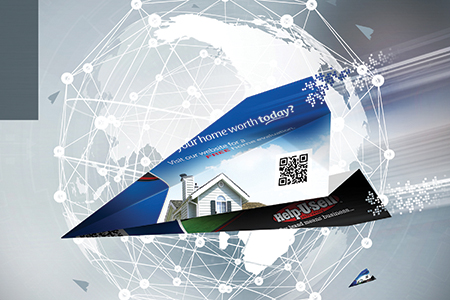While Help-U-Sell offers a modern approach to real estate, the company is certainly no newcomer to the business. Founded in 1976, Help-U-Sell leapt out of the gate with its set-fee, full-service business model, breaking the traditional mold from the onset. Now serving more than 100 offices in 26 states (and counting), the company has stepped up its value proposition with an in-house IT department that offers an all-in-one tech and marketing solution for affiliates. In this special interview, COO Robert “Robbie” Stevens and Chief Development Officer John Powell give us a look under the hood to find out how the Help-U-Sell engine runs, and why its approach to the real estate business has never been more relevant.
Maria Patterson: Help-U-Sell has been around a long time, and now has more than 100 offices serving 26 states. Why does your model still work in today’s market?
John Powell: The model is even more relevant today because of the way the real estate business has changed over the years. Today, technology has solved many of the problems buyers and sellers once had. In 1976 when Help-U-Sell was founded, buyers wanted a free flow of information, and that’s what we did for years. We’d give “information without obligation,” giving buyers addresses and phone numbers so they could drive by and look at properties. Today, that information is available whether brokers like it not. For years, brokers had a monopoly on information, but it’s not a secret anymore because of Zillow, Trulia, realtor.com®, etc. Technology has universally given the consumer the information that Help-U-Sell has been providing for a long time.
MP: What sets Help-U-Sell Real Estate apart in terms of technology?
Robbie Stevens: We created our own IT department eight years ago, which offers our brokers a big advantage. Our IT team only works with our offices, which creates a much better relationship between them. We know all of our offices’ online strategies and goals, and, therefore, service them more efficiently. If you hire a third-party tech firm, it’s hard to get a quick response time. Instead, we developed the tools needed to fit our business model. For example, we handle all the MLS data in-house, which allows us to service our brokers quickly and provide them with new listing data and market statistics. We have that information in real-time.
MP: You’ve opened several offices recently. Is your technology offering part of what’s fueling that growth?
JP: Yes, technology is a big part of it, but overall, most brokers join us because of the pressure of competition from other firms. In today’s environment, many brokers are discounting, which lowers their bottom-line profit. Brokers are getting squeezed tighter and are working harder. They need to be able to increase profitability. We, on the other hand, have a proven, 40-year system, which is built around our fee structure. Brokers save the consumer thousands of dollars, and become more profitable.
There are a lot of new business models unveiled every day—and these models are just that: new. They’re experimenting. We’re not experimenting. We’re very experienced. Brokers like the security of being with a company that has proven its model.
MP: Please explain your set-fee model. A lot of people have the impression that Help-U-Sell is a discount model.
JP: Sellers have never understood commission. Why would it cost them $12,000 to sell a house for $200,000, but $18,000 to sell a house for $300,000? What’s the difference in service between selling the two homes? The answer is always “nothing.” For the consumer, our fixed-fee model is more relevant than ever. We save people thousands of dollars, but we’re not a discounter—we also give them full service. We provide more marketing, and we handle the contracts and closing details—the escrow, the inspection, the appraisal. The fact that we save sellers money, with a business model that makes the broker more profitable, gives us a strong competitive advantage.
MP: What sets your marketing offering apart from other firms?
RS: Our marketing tools are one of the big benefits we offer. Brokers don’t have to go to a third party and purchase out-of-the-box solutions. Having our marketing in-house allows us to respond to the market a lot quicker. We monitor the data and company website to immediately see the behavior of our client base. We apply our technology to MLS data and create automated drip email campaigns. Everything integrates together. At other companies, you have people using one software for CRM, another for website management—they have 10 logins for all different websites. With us, all tools are accessed by one single login. And the technology is proprietary to us—designed specifically to serve our business model and franchises.
MP: What type of brokers are attracted to the Help-U-Sell Real Estate value proposition?
JP: There’s not one type of broker that’s attracted to our model. We attract all ages and all backgrounds. Younger brokers like the technology. They’re tech-savvy and find our tools to be much more effective and efficient. We also attract brokers who have been in the business for 20-30 years; they’re looking for options to be more competitive and profitable. Brokers from all over the country are opening Help-U-Sell offices. We have numerous offices in California, from LA to the Inland Empire. We’ve also opened offices in Texas, Missouri, Florida, and Pennsylvania.
MP: Aside from the set fee, what are some of the biggest differences between the Help-U-Sell model and the traditional brokerage model?
RS: In the traditional model, agents pay for all their IT costs and don’t control it. Help-U-Sell Real Estate is different because the office controls the marketing and invests the capital. We don’t depend on the agent to spend their own money on marketing.
For example, we’ve developed online technology to become more competitive with direct mail. Right now, everyone is pushing online marketing and spending money on social media, Google ads, and teaching agents how to use Facebook and Twitter. Those newer marketing avenues have certainly become relevant, but many agents have gotten lost on traditional marketing like direct mail and signage. You can’t always be looking for that silver bullet, because there is no silver bullet. You need to use a series of marketing initiatives, not just one thing. You must have an online presence and an approach to social marketing, along with the visibility of direct mail and signage. When we ask people, “How did you hear about Help-U-Sell?” they always tell us, “We see you everywhere.”
MP: Why did agents move away from traditional marketing efforts, like direct mail?
RS: It came down to time and money. It became too big of a distraction to go back and forth with the printer and to figure out which neighborhoods to target—and the costs became prohibitive. Internet marketing is a lot cheaper, but the leads are a lot weaker, as well. We’re able to use technology and collective bargaining with our printer to automate direct mail at lower costs.
MP: You’ve been taking on some impressively sized technology projects in-house. Can you tell us more?
RS: We have two big projects this year. One is close to launch (at press time) and the other will launch toward the end of the year. The first involves direct mail. The average office has a marketing budget of about $1,000 a month, which means you can’t afford to get postcards out to every home in your target area. We’re using our technology to lower that cost. Instead of doing blanket coverage to all homes in a zip code, we can go to a smaller target market based on carrier routes. We know when a home goes on the market, the neighbors start talking. Our strategy allows us to get the right message to the right people at the right time. And this would all be done with automation—because of our MLS data, we know of almost every listing that goes on the market. We’ll get the file to the printer and in 3-4 days, the postcard will be sent out. Timing is essential when it comes to marketing.
The other project involves the data we’re acquiring to predict home sales for the next 12 months. This will give our franchisees a huge advantage. It all comes down to data and predictive marketing to determine how long people are staying in a home. We’re looking at hundreds of data points and testing those against what the chances are of a homeowner selling in the next 12 months.
MP: How does the Help-U-Sell value proposition solve the recruiting challenges faced by most traditional firms?
JP: For most brokers, their No. 1 job is to be a recruiter day in and day out. They hire a new agent, get them up and running and productive, then the broker down the street offers them 5 percent more commission split, and you start the recruiting process all over again. We take brokers out of this recruiting revolving door. Our model is a team concept where brokers recruit people to help run the business only when the volume of business dictates. Agents are not generating the business—our business is generated by our marketing system, so if an agent leaves, they aren’t taking a book of business with them. This gives the broker a business with a lot more value since they own the clients, not the agents. This leads to much higher profitability because brokers avoid paying a high commission to compete in the recruiting arena. Agents love it because instead of spending a lot of time and money trying to locate clients, they just work the leads the broker hands them, making them far more productive.
MP: You recently launched new broker websites. What improvements are being offered?
RS: We try to come up with a new template every 18 months or so. About 60 percent of our traffic comes from mobile devices, so we have a responsive template that responds automatically to different devices, including a high-resolution landscape view and faster downloads. We’ve built our templates in WordPress, which allows our brokers to use thousands of WordPress plug-ins to customize the sites.
MP: What does the future of real estate marketing look like, and how do you hope to influence it?
RS: Automation in direct mail is definitely a big piece for our company—online marketing and social media should be an add-on. We’re investing more in automation to figure out how we can become more efficient when it comes to direct mail. We’re also focusing on creating transparency between buyers and sellers. We’re using technology to bring buyers and sellers together so that the agent becomes more of a consultant.
MP: What are your thoughts on the future of the real estate business as a whole?
JP: There’s going to be continued pressure on the real estate business in general, which is going to force change, just like Charles Schwab forced change in the stock business, and Uber disrupted the taxi business. Technology changes things—it empowers the consumer, and when consumers are empowered, they can do business the way they want to do it. I think we’ll continue to see new business models—the old business model is fading fast. Help-U-Sell’s growth pace is going to increase over the next year or two because of the pressures brokers are facing. We’re very optimistic about the future—we’re not afraid of the changes. We’re looking forward to them.
For more information, please visit www.helpusellfranchise.com.
Maria Patterson is RISMedia’s executive editor. Email her your real estate news ideas at maria@rismedia.com.
For the latest real estate news and trends, bookmark RISMedia.com.












